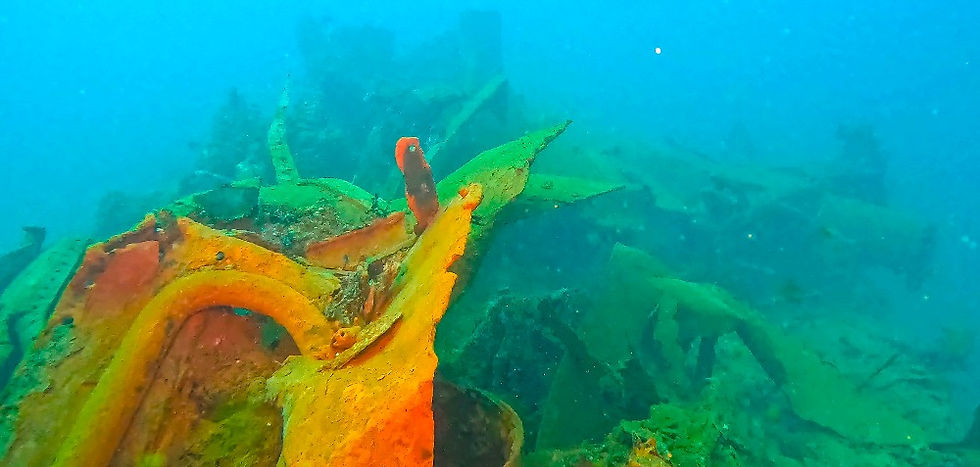

In these days of satellite GPS, super security, 3D mapping and instant information, it is hard to believe that somehow one of Guam's most precious WWII remnants got badly trashed due to getting bad directions. This apparently happened in October 2023. Now, it is well into 2024, and no one seems to know why. The U.S. Navy is clueless. Guam's harbor master is mute. Guam's historic officers have dropped the ball.
Due to an apparent poor anchoring job and an even worse job of raising the anchor by the 350-foot-long oil/chemical tanker MV Pohang Pioneer, the 272-foot WWII Japanese sunken ship Kitsugawa Maru now has a badly damaged bow, no mast and an obliterated bridge.
This ship sits upright in Guam's Apra Harbor. It had an iconic bowgun, a platform of four boxes of ammunition, a coral-covered cargo boom and an upright forward mast and behind that a bridge area with swimmable passageways on port and starboard.
I say "had" because now all of those items either sit in 137 feet of water buried in harbor-bottom silt or are broken and crumpled on the ship's deck. Videos and stills from divers over the last few months confirm one of Guam's and the Pacific's most iconic war remnants is all but a memory.
As early as January 1943, American aircraft and submarines attacked a Japanese cargo carrier inside Guam's Apra Harbor. Seven months later, on Aug. 27, 1943, the USS Snapper hit the Japanese Tokai Maru, anchored in Apra Harbor. The Tokai Maru sank, coming to rest on the German ship Cormoran that was sunk during World War I.
A half-year later, on April 8, 1944, Kitsugawa Maru was part of a supply convoy passing Guam when the same sub, USS Seahorse, hit her aft with a torpedo. Thirty-seven of her sailors were killed in the attack. She was towed to Apra Harbor for repair.
Guam was occupied by Japan at the time. She was further damaged in three separate U.S. air attacks and deemed irreparable. The ship was scuttled by shore guns on June 27, 1944, and came to rest upright, making her one of the most desirable war wrecks in the Pacific to explore and photograph. Desirable, that is, until October 2023.
When Guam's War in the Pacific National Historical Park was established in the late '70s - early '80s, submerged cultural resources became the focus of intense study and exploration. Interest in the submerged resources of the park was logical since over half of the park was underwater.
From the outset, the National Park Service's Submerged Cultural Resources Unit (SCRU) in Santa Fe, New Mexico, led and participated with the government of Guam in efforts to research, document and protect these unique submerged cultural resources like the Japanese wartime ships, planes, tugboats and many other remnants. Guam has over 60 notable war-era remnants in its harbor waters.
The park eventually acquired a boat and developed an enthusiastic crew of local volunteer divers, led by rangers like Rose Manibusan, the first diving female CHamoru ranger and Jim Miculka, a founding team member of the new park. They researched, documented and protected the wrecks and remnants in or near park waters. Hours diving the Tokai Maru, SMS Cormoran and Kitsugawa Maru resulted.
The park team had a rare underwater opportunity in early 1988 when the Cousteau Society invited Guam rangers Miculka and Manibusan to join the famous crew on board the society's windship, the Alcyone. The crew conducted research around Guam as part of its "Rediscovery of the World" tour.
Beginning in December 1987 and continuing into 1988, Miculka and Manibusan and local volunteers, including me, participated in many of the activities, including taking the Cousteau Society divers to the Kitsugawa Maru. Park staff made a video and shot several slides during these adventures with the Cousteau Society and incorporated the media into several interpretive programs.
A 550-page book eventually came from the national and local efforts, listing wartime resources around Micronesia and especially on Guam and Saipan. In November 1989, underwater artist Jerry Livingston from national SCRU came to Guam to work with the park’s team. His uniquely accurate sketches of historical ocean and Great Lakes wrecks in USNP waters put him in demand across the U.S.
His visits resulted in sketches of Guam's Tokai Maru/Cormoran and the Kitsugawa Maru. This major book/report aimed to present information that would be useful for submerged resource site interpretation, protection, and conservation, and contribute to the historical understanding of the Micronesian Islands and their maritime history.
ADVERTISEMENTGuam's ships aren't that hidden, that deep, or that mysterious. Guam only has three Japanese WWII ships sunk in the harbor. One, the Nichiyu Maru, is under the fuel pier and was altered long ago to aid docking of the fuel ships. The other two, Tokai Maru and Kitsugawa Maru, are fairly close to each other in what might be thought of as near the inner harbor. They have been on the charts for decades.
Big ships like the Pioneer usually moor or anchor farther out by Glass Breakwater. The historic ships' locations are known to the harbor master, tug captains and many ships that frequent Apra and Guam. MV Pohang Pioneer is one ship that fits the frequent-visitor description. Any ship of the Pioneer size that comes into the harbor is supposed to report its intention to enter to the harbor master and then will be escorted in some way by using a knowledgeable captain or tug. It is then taken to a proper anchoring site.
So what happened here? This is really unbelievable to many in the diving, tourism, history and boating communities. How did the Pohang Pioneer get to the site directly above the Kitsugawa? The ship is listed on the Guam Register of Historic Sites and is eligible to be on the National Register. It sits on submerged U.S. Navy land underneath U.S. Coast Guard-enforced waterways.
How did this happen? How was a big ship like this allowed to drop anchor here considering all the options in the harbor there are to park a vessel?
So the next question is, will anything be done about this? The Navy says it is working on this, kind of. It says it is working to hold others accountable and wants to prevent or reduce incidents like this. But -- and this is rich-- it says all that water down to its submerged land is not its problem. The bottom of the Kits is touching Navy land so that's theirs. But all that water above, that's not theirs.
The Navy says, "The alleged incident did not occur in 'Naval waters.' Rather, it occurred in waters above Navy-owned submerged lands. We believe there is a misconception regarding Navy-owned submerged lands."
ADVERTISEMENT
So that's someone else's problem. Whose? Coast Guard, GovGuam, Port Authority, Juan Malimanga? Who knows? So I guess while we figure out who actually watches over all that water above Navy land, North Korea can just slip a sub in and shoot a few at GU. I think someone better get this sorted soon.
And we get pretty much the same runaround in nebulous replies from the harbor master who has no idea how the Pioneer got where it got. Guam archaeologists say they passed the info to the Navy. The Navy says it's not investigating anything. Guam Historical Preservation says nothing is happening there. The Navy says it is committed to ensuring compliance with the National Historic Preservation Act Section 110, so it will be documenting the current condition of the ship. When did it last document the condition of the ship so it can compare before and after?
So we sit and wait on the government folks, local and federal. The iconic bowgun of this ship that eluded salvors for decades is now in 137 feet of water, the very edge of safe sport diving. And it is covered in silt. It's not much to see now. The bow area has been scraped of sessile (protective) marine growth and this will accelerate the deterioration of this historic wreck. The mast, ammo platform and cargo boom are trashed. The ammo boxes, save one, are also in the silt. The bridge area is collapsed. This poor little ship took a real beating.
The Pioneer must have realized the anchor was fouled. Instead of sending divers down to see what the problem was and then reporting it and formulating a plan to unfoul it, it just yanked and pulled and moved and yanked some more until what was left of the Kitsugawa finally gave up and let go. The result is Guam, the Pacific and the world have lost an iconic war-era ship to stupidity.
As a person who worked with the park service volunteers for a couple of decades and has spent a lot of time on this ship, I hope this sad incident doesn't get swept under the rug. But I fear there seems to be a lot of federal and local agencies with active brooms right now, not to mention the deafening silence of the civilian Pioneer.
There seems to be a great deal of apathy or lack of responsibility about this incident. I urge the people of Guam to follow up with their local senators, the governor, the Navy, the DoD and the congressional delegate to make sure this gets understood and fixed.
The ship can't be "repaired" so that amazing piece of history is permanently gone. Let's make sure in the future we lose nothing else in Apra Harbor waters because now we don't have that much left.
Subscribe to
our digital
monthly edition













Yorumlar